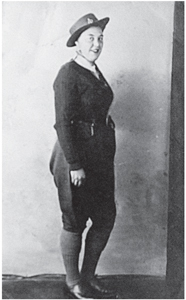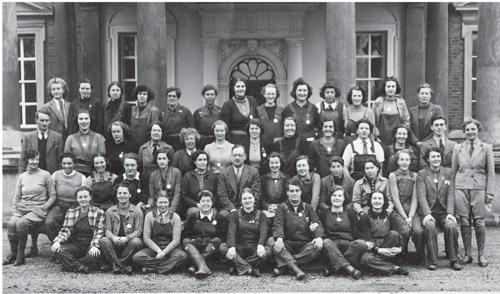Essex Land Girls (6 page)
Authors: Dee Gordon


Joyce Theobald (née Mumford) in full uniform. (Courtesy of Alan Theobald)
One 18-year-old, Kathleen Kellock, wanted to join the army in 1942, but her father ‘wouldn’t allow it’ as she had four brothers in military service; so she took on a boring job in a ball bearing factory in Chelmsford, until being ‘shot at by an enemy aeroplane’ and saved by being pushed to the ground. This affected her so badly that her doctor ‘recommended to her father that she transfer to the Land Army’ (See the
Suffolk Review
of autumn 2004). Similarly,
Audrey Clarke
’s fiancé did not want her to join the armed services as he was in the air force and thought they’d never see each other, so the Land Army was her second choice.
A few girls did have some farming experience. One was
Iris Richardson
, who had been ‘working the land’ in the Rochford area, a great improvement on her previous life as a ‘skivvy’. For her, the WLA seemed like a step upwards.
Generally, however, the girls did not join for the wages, which started out at around 28
s
a week, substantially less than their male counterparts on the farms. Brought up on farms in Canewdon and South Ockendon,
Lillian Woodham
was also used to farm work and had worked (like Iris) as a domestic. As she ‘didn’t want to work in the local margarine factory’ from 1939, and wanted to be ‘out of the firing line’, she too signed up for the WLA.
Ivy Cardy
had been brought up on a farm, with the WLA her ‘second choice’, her first choice having been the WRNS. Although
Rene Wilkinson
was another girl who had been ‘brought up on a farm, with pigs’ her reason for choosing the WLA was less to use her experience and more to do with ‘being with my friends’.
Working ‘on a small holding from the age of 15’ gave
Amy Rogers
some insight into what she was getting into when she plumped for the WLA, while for
Eva Parratt
it was more to do with a love of gardening. As for
Maude Hansford
, she was descended from a line of farmers in Dorset, although herself a shorthand typist living with her family in Thorpe Bay, but as her family were ‘nature loving’ the WLA seemed the most appropriate choice.
Many members have little or no recall of their initial interview or medical, and it seems that many may not have even had a medical.
Ellen Brown
does, however, remember a ‘cursory’ medical undertaken by her own doctor in Leyton, East London, when she was 17 and ‘weighed less than 8 stone’.
Kathy Firmin
had a similar experience in South Woodham Ferrers. Because
Elsie Haysman
had passed her medical for the WRNS she ‘did not need another one for the WLA’.
Iris Richardson
does remember an interview, however, ‘in Rayleigh, when I was 17’. Although the minimum age to join the Land Army was officially 17½, it wasn’t unusual for the girls to lie about their ages, reminiscent of the young men in the First World War.
Edna Green
was one of those who stretched the truth, admitting ‘I was 17 after joining’ which was, in fact, in 1947, when the WLA was still going strong in many areas, and continued to do so until 1950. Initially,
Doreen Morey
, having given her real age, was not old enough for the WLA and was offered, but turned down, the Timber Corps. When asked if she was willing to wait, and it was pointed out that she would be doing ‘threshing’, she agreed as ‘I knew nothing about farm work, and didn’t know what threshing was! I was “called up” six months later and in the meantime had a medical via my own doctor who just sounded my chest and tested my eyesight, declaring I was “okay to go”.’
Lynette Vince
remembered an interview at ‘the recruiting office at Walthamstow, where I joined with my
sister’ having travelled from their home in Wanstead. East Ender
Dorothy Jennings
wrote in her diary of an interview in Oxford Street on 25 May 1943. ‘There were lots of girls there. I was in there for two hours. She put down about my travel sickness. Tried on the hat.’ In August, she refers to ‘the telegram’ telling her to report for duty in Warley.
An interesting account of her interview was given by
Margaret Penfold
from the Chigwell area. She described ‘a bunch of women with fancy hats and Burberrys and posh voices querying why an office worker should want to work on the land’. Another East Ender who ended up in Essex was interviewed in Oxford Street by a lady with what she described as ‘a five pound note voice’.
‘My first attempt to join the WLA was at 16, and I was turned down, so went back six months later at 17, in 1941’ is
Ivy Cardy
’s memory.
Irene Verlander
joined up ‘at the Rayleigh office in 1943’. She was ‘offered a job in Wales’ initially, but withdrew her application until something nearer turned up!
Amy Rogers
’ nearest recruitment office was ‘at Bishops Stortford’ (Hertfordshire) and she recalls signing the forms there. This was where
Maude Hansford
also enrolled, having registered first at the Labour Exchange in Southend-on-Sea in 1939.
A more detailed account of her interview was given by dressmaker
Gladys Pudney
from Stratford, who had been working for a couturier making clothes for Princess Marina and debutantes – considered a luxury job. ‘I was interviewed at the Agricultural College in Writtle by a Mrs Melville on 15 June 1942. She assessed me and asked me what interested me. I remember saying I did not want to crawl around in the dirt in the fields, and Mrs Melville made a note …’, though perhaps to little effect.

Irene Verlander (née Hart) in uniform. (Courtesy of Linda Medcalf )
The cursory nature of many medicals was illustrated by
Connie Robinson
’s account. From Chadwell Heath, Connie ‘signed up with my older sister. We went to our doctor for an examination,’ but left feeling that ‘if you could breathe, you were in’. It was not uncommon for anyone who had a childhood health issue to lie about her background to make sure she got into the Land Army if this was her chosen path.
Vera Osborne
did this after failing a medical for the Women’s Air Force, having had tuberculosis in her hands and feet as an infant.
It was generally accepted (and detailed in Joan Mant’s book,
All Muck, Now Medals
) that if you turned up smart for the interview, you would be reminded of the nature of the work, e.g. cleaning out cowsheds dressed in dungarees and wellies.
Successful interviewees were subsequently presented with an enamelled brass badge, with a royal crown indicating the queen’s patronage, worn on a sweater or hat. The Timber Corps’ badge was similar, with the corn sheaf replaced by a fir tree, worn on their berets. Many of these badges survive.
All new recruits were asked to sign a pledge card, which read:
You are now a member of the Women’s Land Army.
You are pledged to hold yourself available for service on the land for the period of the war.
You have promised to abide by the conditions of training and employment of the Women’s Land Army; its good name is in your hands.
You have made the home fields your battlefield. Your country relies on your loyalty and welcomes your help.
Interestingly, the
Essex Newsman
ran the following advert on 18 November 1939:
Women trained either at Agricultural Institutes or Farms are now available for engagement by farmers as milkers, pig men, poultry workers, tractor drivers, land workers and horticultural workers. All candidates personally recommended. For rates of pay, conditions of employment, etc. apply to The Secretary, WLA, New Poultry Station, Writtle, Chelmsford.
Similarly, one enterprising Essex Land Girl, Eileen Burrows (née Beswick), advertised her availability in
Farmers Weekly
. This was before demand exceeded supply …
The Regal Cinema in Bellingham Lane, Rayleigh, was one of a number of venues used during the war as an enlistment centre for the WLA. Many girls from the East End joined up at the busy recruitment office in Oxford Street, in the West End of London, and there was another in Walthamstow. Others were interviewed by county representatives, with one particularly important criteria emphasised (apart from physical stamina) – the ability to ride a bicycle.
As with the First World War, once the war had kicked in recruitment campaigns took place regularly throughout the county, with Chelmsford particularly prolific, as the county town of Essex. Such campaigns emphasised the attractions of the open air and healthy lifestyle, bearing in mind that this was a service where you could acquire a suntan, since stockings and skirts were not compulsory. However, no mention was made of the hard life, the low pay, long hours, limited holidays and unfair (compared to other services) rewards!
Nationally, over 20 million households in Britain were sent a
National Service
booklet in 1939, and this included a section appealing for volunteers for the WLA, with the option of working for a mobile force or for local work only.
Training for Land Girls ranged from non-existent to comprehensive. Writtle, near Chelmsford, was the centre of much of the work of the Essex branch of the WLA. This housed the Institute of Agriculture during the war years, and women were given training courses in, for example, pest and vermin control, a crucial role given that one rat could eat 50kg of food in one year. One such trainee wrote of ‘threading worms by passing a strychnine thread through them to be used for poisoning moles. We had no protection and our hands soon developed sores.’
Other instruction included compost making, horticulture, poultry keeping, making hurdles (to stop aircraft landing) and vegetable growing. New science laboratories were utilised for lectures, and there was plenty of hands-on experience in the surrounding fields, or even in the front lawns, which had been ploughed up to grow vegetables. Written, oral and practical examinations followed the three weeks’ or two months’ training, dependent upon the course. There were also assessments based on their work output.
The 1943 exam paper for a qualification in ‘Pest Control and Poisons’ included such questions as:
Give three examples of how to trace the presence of rats.
If on the day after poisoning, you were accused by a farmer of poisoning a chicken, what would you say to the farmer?
In November 1939, the Henry Ford Institute of Agricultural Engineering at Boreham House was already providing training for WLA members in driving and caring for the large numbers of tractors destined to play a part in increasing the supply of home-grown foodstuffs. Boreham House, a twenty-four room mansion with 2,000 acres near Chelmsford, was owned by Henry Ford, employing more than 200 people growing sprouts, peas, cabbages, cucumbers, asparagus, tomatoes, wheat, barley, potatoes, and sugar beet, not to mention the 135,000 apple, plum and cherry trees and the cattle and pig farming operation. It became a training centre in 1937.
Students stayed in the institute or nearby cottages for a month, and
Commercial Motor
announced that the trainees were ‘keen and enthusiastic … with little or nothing to unlearn … they are sent out capable of doing a useful day’s work on any farm’. Around 150 women completed courses, which included such subjects as ‘the principles of gasoline engine carburetion’.

